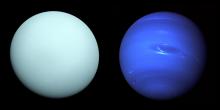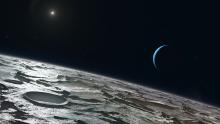Listen to today's episode of StarDate on the web the same day it airs in high-quality streaming audio without any extra ads or announcements. Choose a $8 one-month pass, or listen every day for a year for just $30.
You are here
Neptune III
Neptune is the bluest planet in the solar system. Most of that color comes from methane atop the planet’s atmosphere. It absorbs red light, allowing only blue light to reflect back into space. But Neptune is too blue for methane to account for all of the color. So far, though, astronomers don’t know what else might be enhancing the blue.
It’s just one of the mysteries about the Sun’s most remote major planet. And solutions to many of them probably require a direct look at Neptune’s atmosphere.
So far, only one spacecraft has visited Neptune. Voyager 2 flew past it in 1989. Just about everything else we know about Neptune has come from telescopes on or near Earth. But even though Neptune is four times the diameter of Earth, it’s so far away that it’s a tiny target.
Knowing more about Neptune, though, will tell us more about how all the planets of the solar system took shape. It’ll also tell us more about planets in other star systems. About a third of the planets discovered to date are similar to Neptune.
In a recent study, a team of scientists suggested parachuting a probe into Neptune’s atmosphere. It would measure the composition, temperature, and structure of the air and the clouds. The measurements would answer many questions — while leaving plenty of mystery about this blue giant.
Neptune is at its brightest now, although you need a telescope to see it. It’s low in the southeast at nightfall, near the bottom of the outline of Aquarius.






